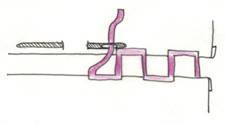Most of the Charity Doll patterns were designed for Doll Clubs or people who were experienced in making soft dolls. Therefore, directions are brief or non-existent. Here are some basic dollmaking guidelines that apply to all of the projects:
Doll Making Supplies:
• Freezer paper for making templates
• Body fabrics
• Clothing fabrics
• Matching threads
• Fraychek, Stop Fray or diluted white glue
• Polyester Fiberfil for stuffing
• Acrylic yarn for hair
• Turning tools or chopsticks and straws
• Stuffing tools or flat head screwdrivers
• Acrylic paints – white, black, red, blue, brown
• Small paintbrushes – 10-0 liner, #2 flat
• Waterproof permanent markers such as Pigma Pens or Zig Millennium in brown and black
• Colored pencils and or crayons for coloring lips and cheeks
• Optional: embroidery thread for embroidering faces
• Optional: Crystal Lacquer for adding shine to eyes and mouths
1. Sewing template dolls - All of the dolls EXCEPT the Johns Hopkins and Hospital Doll are TEMPLATES. This means you will sew on the line and then cut out the doll beyond the line, adding a ¼” seam allowance. Make sure you leave enough room between each pattern to add this seam allowance after sewing. You can copy the pattern onto cardstock, and then trace around pattern on wrong side of fabric with a pencil. Sew on the pencil line. This becomes more difficult when working with darker ethnic fabric.
The easiest way to sew a template doll is to trace the doll pattern without seam allowance on Freezer Paper. This is paper with a waxy coating on one side used to wrap meat before freezing. Iron cut-out pattern, waxy side down, on the wrong side of a doubled piece of fabric. Then sew along the edge of the freezer paper, leaving open where indicated on the pattern. After sewing, carefully remove the freezer paper pattern, which can be reused several times before discarding. It is helpful to use an open toe foot on your sewing machine for this step, because it makes it easier to see the line. Also, be sure and use a shorter stitch length than normal (1.5 to 2 European or 12-14 stitches per inch American.) Needle down position (if your sewing machine has this option) is also helpful.
2. Turning dolls right side out – Before turning doll use a drop of fray check, stop fray, or diluted white glue and put on seam allowance only at crotch, armpit, and neck, along with any other extreme curve (such as a thumb or ankle) that will need to be clipped to turn properly. Then clip all curves. This applies to the clothing also, where you need to clip under the arms or the crotch of pants before turning. We sell several delightful turning tools at Dollmaker’s Journey, and if you decide to pursue dollmaking as a hobby they are very useful. However, when teaching large groups it is easier to give everyone a chopstick (get the kind with pointed end from a Chinese restaurant) and a sturdy straw (most fast food restaurants have great ones.) Place the straw inside the doll at the end of an appendage (such as an arm, leg or head). Place the chopstick on the outside touching the tip of the straw. Gently push chopstick toward straw and push fabric onto chopstick until that part is right side out. Do each part of doll separately and then turn whole doll right side out. Then use the pointed end of the chopstick on the inside to smooth out all the turned seams
3. Stuffing dolls – We also sell some wonderful tools useful for stuffing dolls, including hemostats and tiny finger stuffers. However, in a large group it is best to have everyone bring a flat-headed screwdriver with a comfortable handle. Use polyester Fiberfil for stuffing, because some people are allergic to wool. Begin by stuffing extremities (arms, then legs, then head, then body.) The flat head of the screwdriver enables you to guide more stuffing just under the surface of the doll skin to areas that need help. Begin with small amounts of stuffing, making sure it gets into the ends of the toes and hands. Then add more stuffing until doll is firm and head is a nice shape.
4. Closing seams – If the doll body is covered by clothes that will not be removed, you can whip stitch the opening closed. However, a more professional method is to ladder stitch the opening closed. This stitch is also used to attach arms, heads, etc. and provides an almost invisible closure.

5. Painting Faces – All faces may be embroidered or painted. However, we request you do not use beads for eyes because these dolls are designed for children and beaded eyes can be a choking hazard. Begin by lightly drawing in the face with a regular pencil. Mechanical pencils create a fine line that is perfect. If you make a mistake, you can erase the pencil and try again. If you really mess up the face, just draw another face on the other side of the doll and cover your mistake with painted hair.
We use Zig Millennium or Pigma permanent markers usually found in the scrap booking section of your craft store, size .05 or .01 (for eyelashes). They are also available at office supply stores. The advantage of these pens is that they are waterproof, permanent, and won’t bleed. Colors you need are brown, black, and red, orange or pink for lips. You will also need several small brushes (10 – O liner brush and #2 flat brush) and acrylic paint. For most of these projects black and white paint is sufficient. You can also use Gesso instead of white paint. To make eyes look more realistic try using an off-white acrylic paint instead of stark white. If you are doing Caucasian dolls, you might also want some colored paint (brown, green, blue, violet) for the iris. We like to seal the eyes and lips with Crystal Lacquer available at Dollmaker’s Journey (URL).
The best face directions are under the Haiti dolls and are designed for African dolls.(URL) You can also try different ethnic faces using the Ethnic face diagram created by Joan Jansen (URL). These faces were designed for embroidery but work just as well for painted faces. They are sized to fit the Hospital and Johns Hopkins dolls if you decide to dress them and give them hair and faces for a charity other than a hospital. The final touch is to add blush to the cheeks. Bittersweet or Carnation pink crayons work well. Shading around the eyes, nose and lips can be done with Prismacolor pencils. Our favorite colors for ethnic dolls are Terra Cotta and Gray.
6. Signing dolls (optional) – Feel free to sign your name/club/church on the rear end of each doll using a permanent marker.
|




